Charles E W Bean, Diaries, AWM38 3DRL 606/228/1 - Folder - Part 2
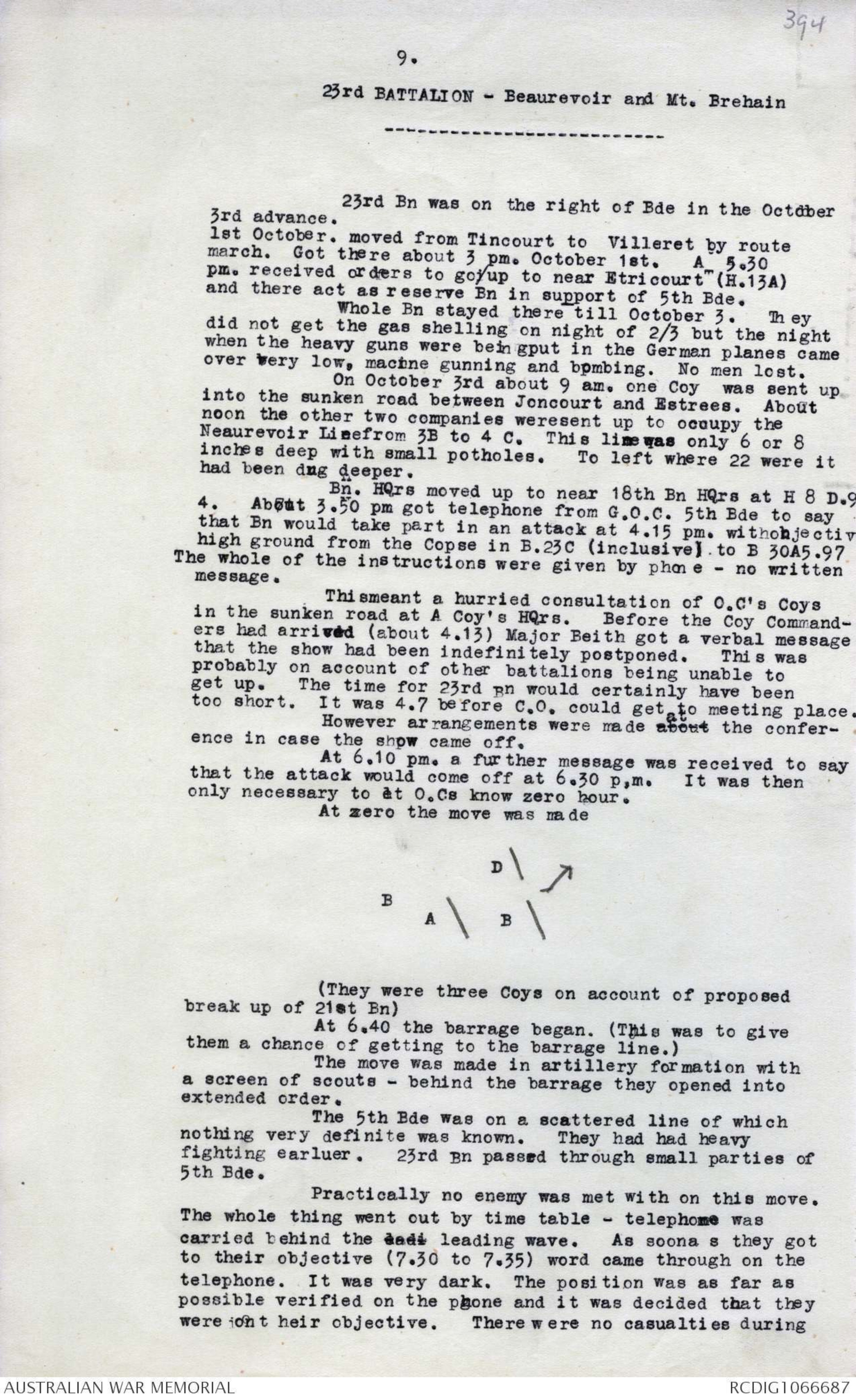
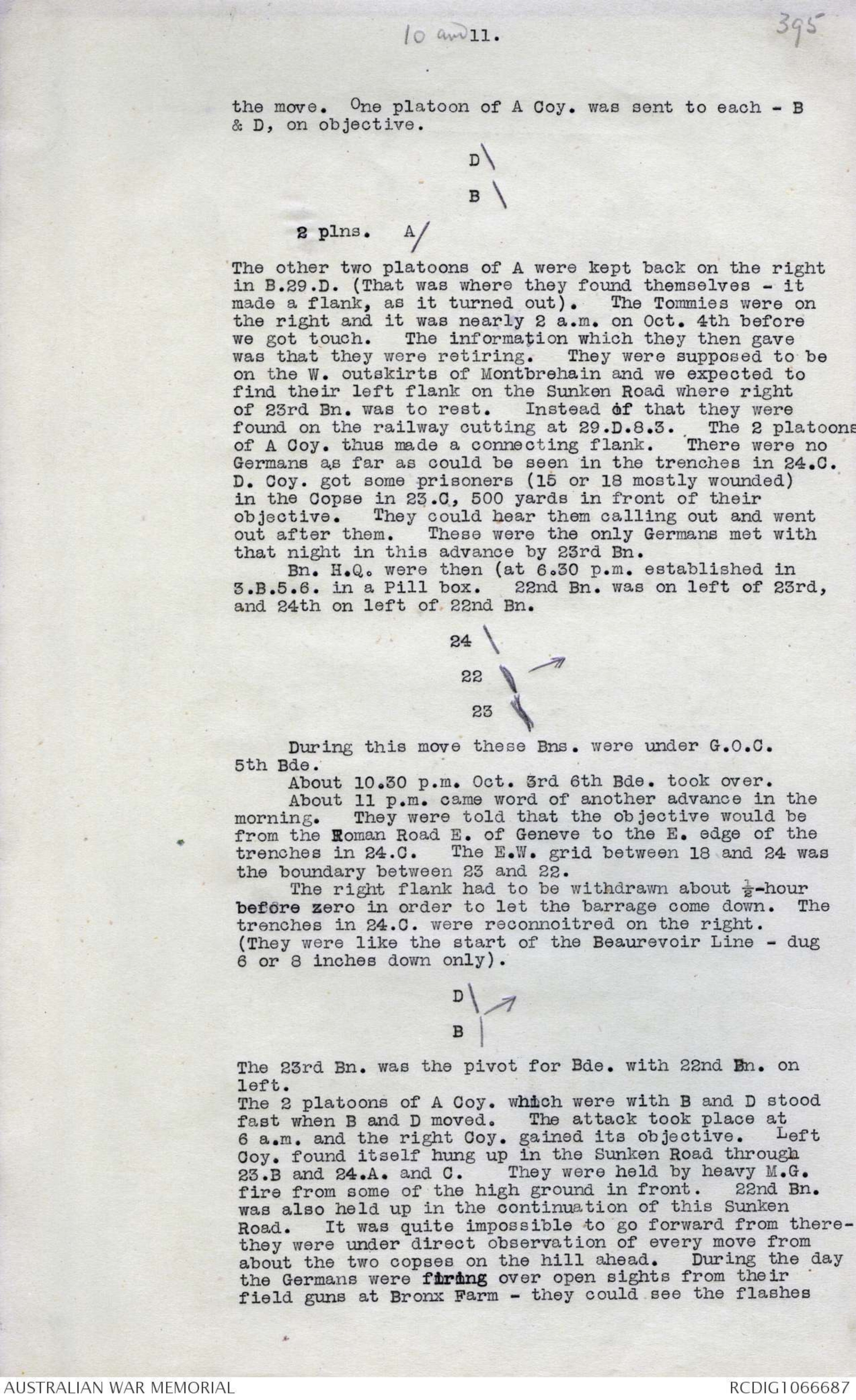
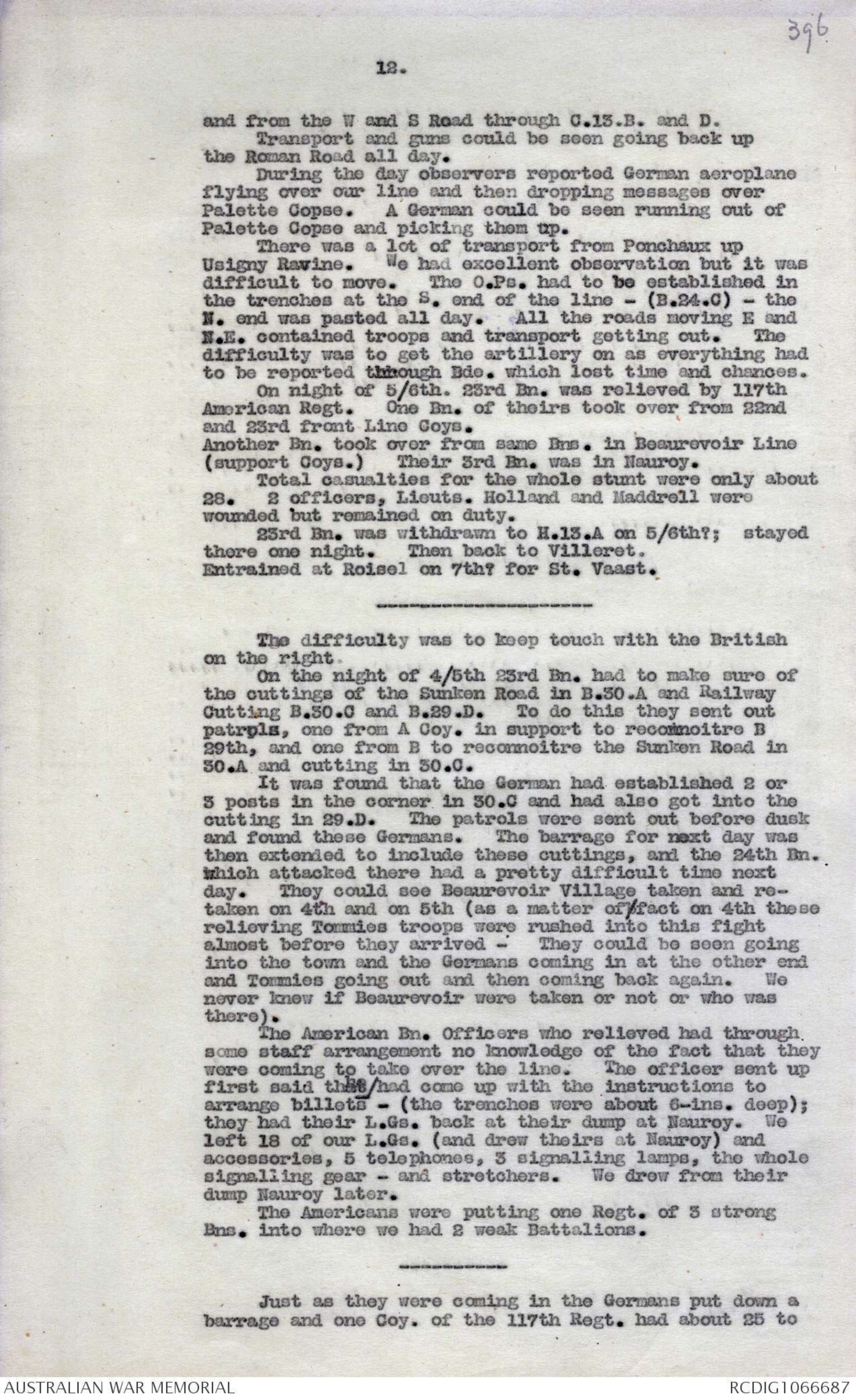
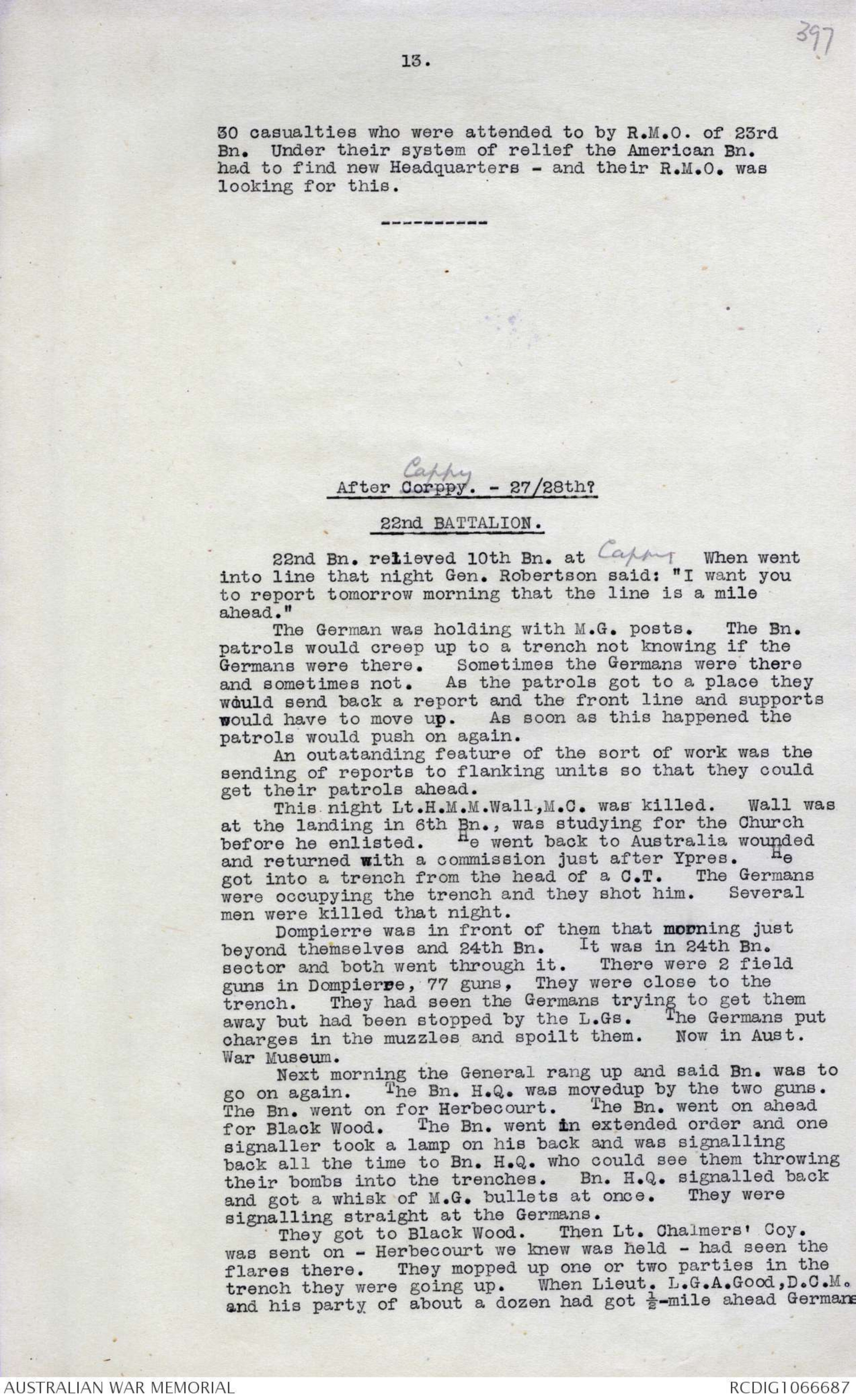
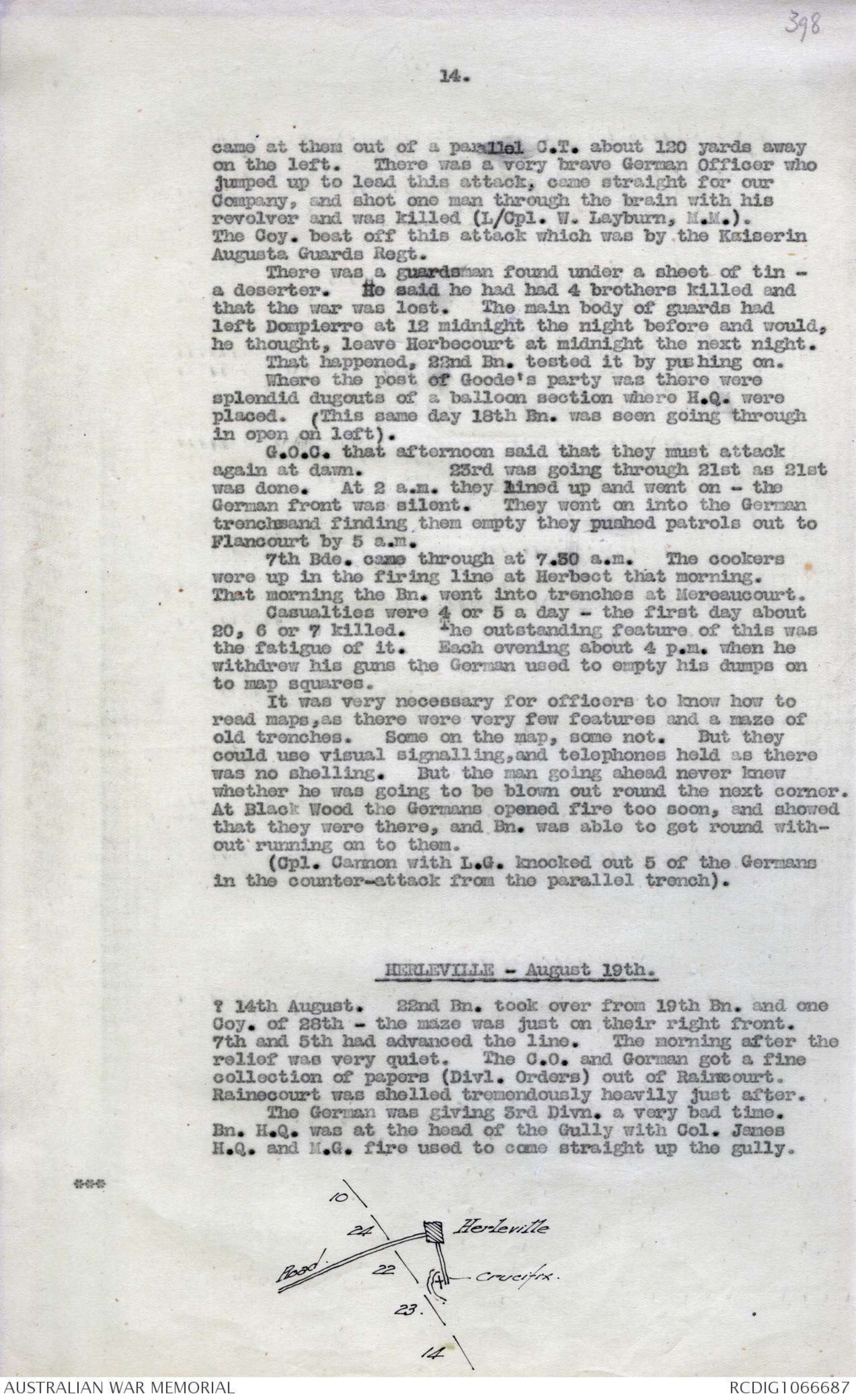
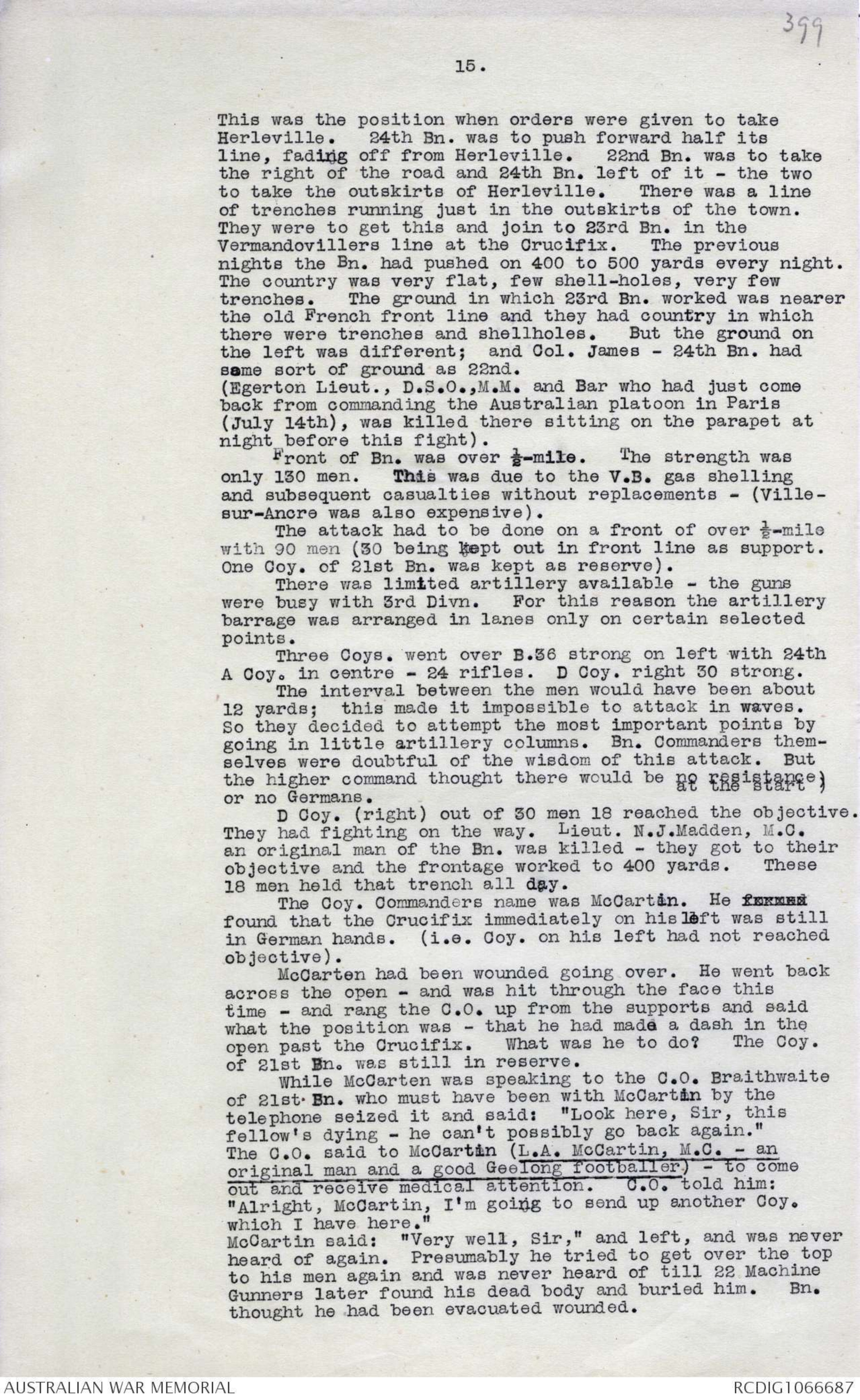

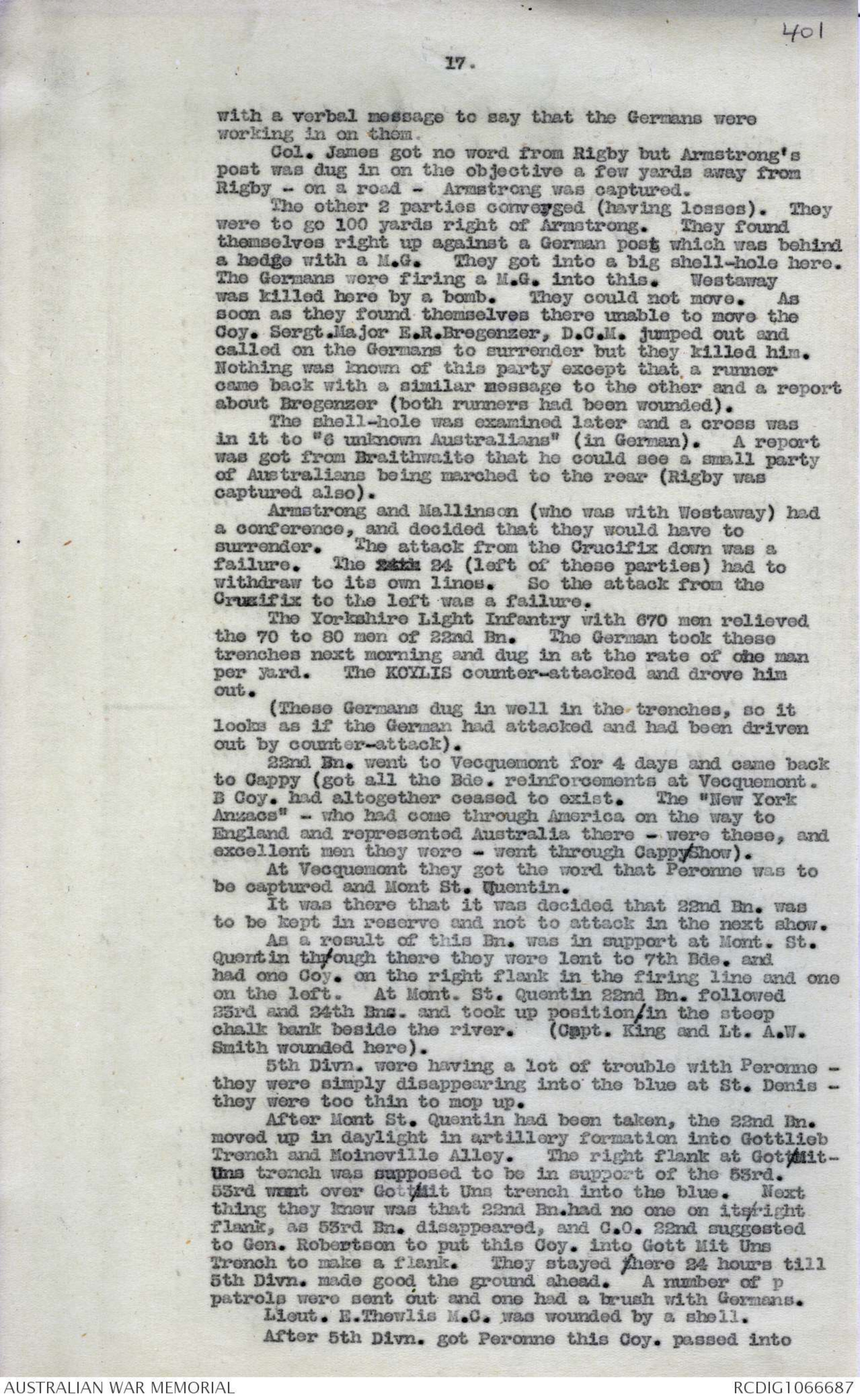
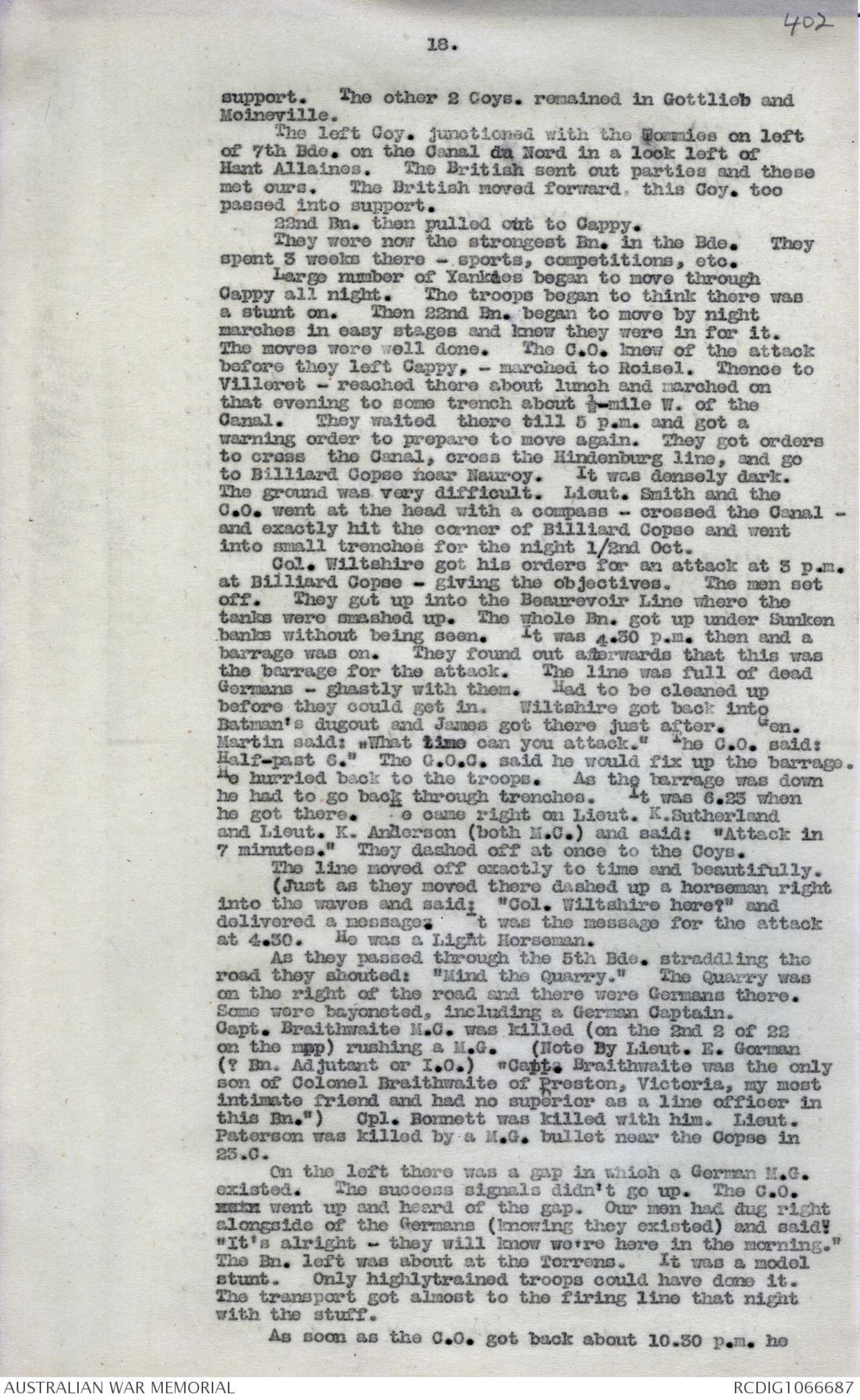
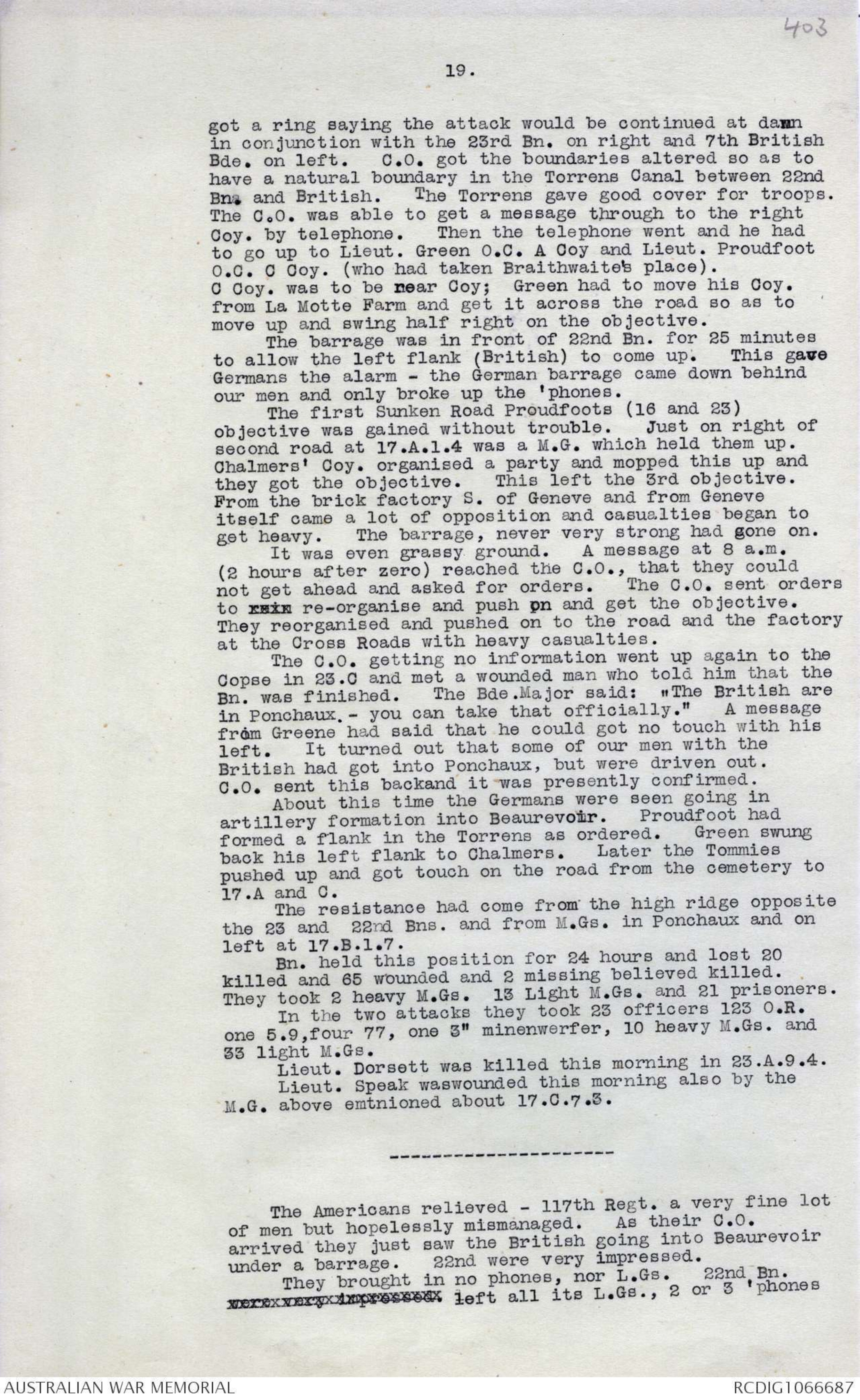
394
9.
23rd BATTALION - Beaurevoir and Mt. Brehain
23rd Bn was on the right of Bde in the October
3rd advance.
1st October. moved from Tincourt to Villeret by route
march. Got there about 3 pm. October 1st. AT 5.30
pm. received orders to goi up to near Etricourt (H.13A)
and there act as reserve Bn in support of 5th Bde.
Whole Bn stayed there till October 3. They
did not get the gas shelling on night of 2/3 but the night
when the heavy guns were being put in the German planes came
over very low, machine gunning and bombing. No men lost.
On October 3rd about 9 am. one Coy, was sent up
into the sunken road between Joncourt and Estrees. About
noon the other two companies were sent up to occupy the
Neaurevoir Line from 3B to 4 C. This line was only 6 or 8
inches deep with small potholes. To left where 22 were it
had been dug deeper.
Bn. HQrs moved up to near 18th Bn HQrs at H 8 D.9 4.
About 3.50 pm got telephone from G.O.C. 5th Bde to say
that Bn would take part in an attack at 4.15 pm. with objectiv
high ground from the Copse in B.23C (inclusive) to B 30A5.97
The whole of the instructions were given by phone - no written
message.
This meant a hurried consultation of O.C's Coys
in the sunken road at A Coy's HQrs. Before the Coy Commanders
had arrived (about 4.13) Major Beith got a verbal message
that the show had been indefinitely postponed. This was
probably on account of other battalions being unable to
get up. The time for 23rd Bn would certainly have been
too short. It was 4.7 before C.0. could get to meeting place.
However arrangements were made about at the conference
in case the show came off.
At 6.10 pm. a further message was received to say
that the attack would come off at 6.30 p,m. It was then
only necessary to let O.Cs know zero hour.
At zero the move was made
Diagram - see original document
(They were three Coys on account of proposed
break up of 21st Bn)
At 6.40 the barrage began. (This was to give
them a chance of getting to the barrage line.)
The move was made in artillery formation with
a screen of scouts - behind the barrage they opened into
extended order.
The 5th Bde was on a scattered line of which
nothing very definite was known. They had had heavy
fighting earluer. 23rd Bn passed through small parties of
5th Bde.
Practically no enemy was met with on this move.
The whole thing went out by time table - telephone was
carried behind the ladi leading wave. As soon as they got
to their objective (7.30 to 7.35) word came through on the
telephone. It was very dark. The position was as far as
possible verified on the phone and it was decided that they
were on their objective. There were no casualties during
395
10 and 11.
the move. One platoon of A Coy. was sent to each - B
& D, on objective.
Diagram - see original document
The other two platoons of A were kept back on the right
in B.29.D. (That was where they found themselves - it
made a flank, as it turned out). The Tommies were on
the right and it was nearly 2 a.m. on Oct. 4th before
we got touch. The information which they then gave
was that they were retiring. They were supposed to be
on the W. outskirts of Montbrehain and we expected to
find their left flank on the Sunken Road where right
of 23rd Bn. was to rest. Instead of that they were
found on the railway cutting at 29.D.8.3. The 2 platoons
of A Coy. thus made a connecting flank. There were no
Germans as far as could be seen in the trenches in 24.C.
D. Coy. got some prisoners (15 or 18 mostly wounded)
in the Copse in 23.C, 500 yards in front of their
objective. They could hear them calling out and went
out after them. These were the only Germans met with
that night in this advance by 23rd Bn.
Bn. H.Q. were then (at 6.30 p.m. established in
3.B.5.6. in a Pill box. 22nd Bn. was on left of 23rd,
and 24th on left of 22nd Bn.
Diagram - see original document
During this move these Bns. were under G.O.C.
5th Bde.
About 10.30 p.m. Oct. 3rd 6th Bde. took over.
About 11 p.m. came word of another advance in the
morning. They were told that the objective would be
from the Roman Road E. of Geneve to the E. edge of the
trenches in 24.C. The E.W. grid between 18 and 24 was
the boundary between 23 and 22.
The right flank had to be withdrawn about ½-hour
before zero in order to let the barrage come down. The
trenches in 24.C. were reconnoitred on the right.
(They were like the start of the Beaurevoir Line - dug
6 or 8 inches down only).
Diagram - see original document
The 23rd Bn. was the pivot for Bde. with 22nd Bn. on
left.
The 2 platoons of A Coy. which were with B and D stood
fast when B and D moved. The attack took place at
6 a.m. and the right Coy. gained its objective. Left
Coy. found itself hung up in the Sunken Road through
23.B and 24.A. and C. They were held by heavy M.G.
fire from some of the high ground in front. 22nd Bn.
was also held up in the continuation of this Sunken
Road. It was quite impossible to go forward from there-
they were under direct observation of every move from
about the two copses on the hill ahead. During the day
the Germans were firing over open sights from their
field guns at Bronx Farm - they could see the flashes
396
12.
and from the W and S Road through C.13.B. and D.
Transport and guns could be seen going back up
the Roman Road all day.
During the day observers reported German aeroplane
flying over our line and then dropping messages over
Palette Copse. A German could be seen running out of
Palette Copse and picking them up.
There was a lot of transport from Ponchaux up
Usigny Ravine. We had excellent observation but it was
difficult to move. The O.Ps. had to be established in
the trenches at the S. end of the line - (B.24.C) - the
N. end was pasted all day. All the roads moving E and
N.E. contained troops and transport getting out. The
difficulty was to get the artillery on as everything had
to be reported through Bde. which lost time and chances.
On night of 5/6th. 23rd Bn. was relieved by 117th
American Regt. One Bn. of theirs took over from 22nd
and 23rd front Line Coys.
Another Bn. took over from same Bns. in Beaurevoir Line
(support Coys). Their 3rd Bn. was in Nauroy.
Total casualties for the whole stunt were only about
28. 2 officers, Lieuts. Holland and Maddrell were
wounded but remained on duty.
23rd Bn. was withdrawn to H.13.A on 5/6th?; stayed
there one night. Then back to Villeret.
Entrained at Roisel on 7th? for St. Vaast.
The difficulty was to keep touch with the British
on the right.
On the night of 4/5th 23rd Bn. had to make sure of
the cuttings of the Sunken Road in B.30.A and Railway
Cutting B.30.C and B.29.D. To do this they sent out
patrols, one from A Coy. in support to reconnoitre B
29th, and one from B to reconnoitre the Sunken Road in
30.A and cutting in 30.C.
It was found that the German had established 2 or
3 posts in the corner in 30.C and had also got into the
cutting in 29.D. The patrols were sent out before dusk
and found these Germans. The barrage for next day was
then extended to include these cuttings, and the 24th Bn.
which attacked there had a pretty difficult time next
day. They could see Beaurevoir Village taken and re-taken
on 4th and on 5th (as a matter of b fact on 4th these
relieving Tommies troops were rushed into this fight
almost before they arrived - They could be seen going
into the town and the Germans coming in at the other end
and Tommies going out and then coming back again. We
never knew if Beaurevoir were taken or not or who was
there).
The American Bn. Officers who relieved had through,
some staff arrangement no knowledge of the fact that they
were coming to take over the line. The officer sent up
first said that ^he had come up with the instructions to
arrange billets - (the trenches were about 6-ins. deep);
they had their L.Gs. back at their dump at Nauroy. We
left 18 of our L.Gs. (and drew theirs at Nauroy) and
accessories, 5 telephones, 3 signalling lamps, the whole
signalling gear - and stretchers. We drew from their
dump Nauroy later.
The Americans were putting one Regt. of 3 strong
Bns. into where we had 2 weak Battalions.
Just as they were coming in the Germans put down a
barrage and one Coy. of the 117th Regt. had about 25 to
397
13.
30 casualties who were attended to by R.M.O. of 23rd
Bn. Under their system of relief the American Bn.
had to find new Headquarters - and their R.M.O. was
looking for this.
After Corppy Cappy. - 27/28th?
22nd BATTALION.
22nd Bn. relieved 10th Bn. at Cappy When went
into line that night Gen. Robertson said: "I want you
to report tomorrow morning that the line is a mile
ahead."
The German was holding with M.G. posts. The Bn.
patrols would creep up to a trench not knowing if the
Germans were there. Sometimes the Germans were there
and sometimes not. As the patrols got to a place they
would send back a report and the front line and supports
would have to move up. As soon as this happened the
patrols would push on again.
An outatanding feature of the sort of work was the
sending of reports to flanking units so that they could
get their patrols ahead.
This night Lt.H.M.M.Wall,M.C. was killed. Wall was
at the landing in 6th Bn., was studying for the Church
before he enlisted. He went back to Australia wounded
and returned with a commission just after Ypres. He
got into a trench from the head of a C.T. The Germans
were occupying the trench and they shot him. Several
men were killed that night.
Dompierre was in front of them that morning just
beyond themselves and 24th Bn. It was in 24th Bn.
sector and both went through it. There were 2 field
guns in Dompierre, 77 guns, They were close to the
trench. They had seen the Germans trying to get them
away but had been stopped by the L.Gs. The Germans put
charges in the muzzles and spoilt them. Now in Aust.
War Museum.
Next morning the General rang up and said Bn. was to
go on again. The Bn. H.Q. was moved up by the two guns.
The Bn. went on for Herbecourt. The Bn. went on ahead
for Black Wood. The Bn. went in extended order and one
signaller took a lamp on his back and was signalling
back all the time to Bn. H.Q. who could see them throwing
their bombs into the trenches. Bn H.Q. signalled back
and got a whisk of M.G. bullets at once. They were
signalling straight at the Germans.
They got to Black Wood. Then Lt. Chalmers' Coy.
was sent on - Herbecourt we knew was held - had seen the
flares there. They mopped up one or two parties in the
trench they were going up. When Lieut. L.G.A.Good,D.C.M.
and his party of about a dozen had got ½-mile ahead Germans
398
14.
came at them out of a parallel C.T. about 120 yards away
on the left. There was a very brave German Officer who
jumped up to lead this attack, came straight for our
Company, and shot one man through the brain with his
revolver and was killed (L/Cpl. W. Layburn, M.M.).
The Coy. beat off this attack which was by. the Kaiserin
Augusta Guards Regt.
There was a guardsman found under a sheet of tin -
a deserter. He said he had had 4 brothers killed and
that the war was lost. The main body of guards had
left Dompierre at 12 midnight the night before and would,
he thought, leave Herbecourt at midnight the next night.
That happened, 22nd Bn. tested it by pushing on.
Where the post of Goode's party was there were
splendid dugouts of a balloon section where H.Q. were
placed. (This same day 18th Bn, was seen going through
in open on left).
G.O.C. that afternoon said that they must attack
again at dawn. 23rd was going through 21st as 21st
was done. At 2 a.m. they lined up and went on - the
German front was silent. They went on into the German
trenches and finding them empty they pushed patrols out to
Flancourt by 5 a.m.
7th Bde, came through at 7.30 a.m. The cookers
were up in the firing line at Herbect that morning.
That morning the Bn. went into trenches at Mereaucourt.
Casualties were 4 or 5 a day - the first day about
20, 6 or 7 killed. The outstanding feature of this was
the fatigue of it. Each evening about 4 p.m. when he
withdrew his guns the German used to empty his dumps on
to map squares.
It was very necessary for officers to know how to
read maps, as there were very few features and a maze of
old trenches. Some on the map, some not. But they
could use visual signalling, and telephones held as there
was no shelling. But the man going ahead never knew
whether he was going to be blown out round the next corner.
At Black Wood the Germans opened fire too soon, and showed
that they were there, and Bn. was able to get round without
running on to them.
(Cpl. Cannon with L.G. knocked out 5 of the Germans
in the counter-attack from the parallel trench).
HERLEVILLE - August 19th.
? 14th August. 22nd Bn. took over from 19th Bn. and one
Coy. of 28th - the maze was just on their right front.
7th and 5th had advanced the line. The morning after the
relief was very quiet. The C.O. and Gorman got a fine
collection of papers (Divl. Orders) out of Raincourt.
Rainecourt was shelled tremendously heavily just after.
The German was giving 3rd Divn. a very bad time.
Bn. H.Q. was at the head of the Gully with Col. James
H.Q. and M.G. fire used to come straight up the gully.
***
Diagram - see original document
399
15.
This was the position when orders were given to take
Herleville. 24th Bn. was to push forward half its
line, fading off from Herleville. 22nd Bn. was to take
the right of the road and 24th Bn. left of it - the two
to take the outskirts of Herleville. There was a line
of trenches running just in the outskirts of the town.
They were to get this and join to 23rd Bn. in the
Vermandovillers line at the Crucifix. The previous
nights the Bn. had pushed on 400 to 500 yards every night.
The country was very flat, few shell-holes, very few
trenches. The ground in which 23rd Bn. worked was nearer
the old French front line and they had country in which
there were trenches and shellholes. But the ground on
the left was different; and Col. James - 24th Bn. had
same sort of ground as 22nd.
(Egerton Lieut., D.S.O.,M.M. and Bar who had just come
back from commanding the Australian platoon in Paris
(July 14th), was killed there sitting on the parapet at
night before this fight).
Front of Bn. was over ½-mile. The strength was
only 130 men. This was due to the V.B. gas shelling
and subsequent casualties without replacements - (Ville-sur-Ancre
was also expensive).
The attack had to be done on a front of over ½-mile
with 90 men (30 being kept out in front line as support.
One Coy. of 21st Bn. was kept as reserve).
There was limited artillery available - the guns
were busy with 3rd Divn. For this reason the artillery
barrage was arranged in lanes only on certain selected
points.
Three Coys. went over B.36 strong on left with 24th
A Coy. in centre - 24 rifles. D Coy. right 30 strong.
The interval between the men would have been about
12 yards; this made it impossible to attack in waves.
So they decided to attempt the most important points by
going in little artillery columns. Bn. Commanders themselves
were doubtful of the wisdom of this attack. But
the higher command thought there would be no resistance at the start)
or no Germans.
D Coy. (right) out of 30 men 18 reached the objective.
They had fighting on the way. Lieut. N.J.Madden, M.C.
an original man of the Bn. was killed - they got to their
objective and the frontage worked to 400 yards. These
18 men held that trench all day.
The Coy. Commanders name was McCartin. He forund
found that the Crucifix immediately on his left was still
in German hands. (i.e. Coy. on his left had not reached
objective).
McCarten had been wounded going over. He went back
across the open - and was hit through the face this
time - and rang the C.0. up from the supports and said
what the position was - that he had made a dash in the
open past the Crucifix. What was he to do? The Coy.
of 21st Bn. was still in reserve.
While McCarten was speaking to the C.O. Braithwaite
of 21st Bn. who must have been with McCartin by the
telephone seized it and said: "Look here, Sir, this
fellow's dying - he can't possibly go back again."
The C.O. said to McCartin (L.A. McCartin, M.C. - an
original man and a good Geelong footballer) - to come
out and receive medical attention. C.O. told him:
"Alright, McCartin, I'm going to send up another Coy.
which I have here."
McCartin said: "Very well, Sir," and left, and was never
heard of again. Presumably he tried to get over the top
to his men again and was never heard of till 22 Machine
Gunners later found his dead body and buried him. Bn.
thought he had been evacuated wounded.
400
16.
This left Lieut. L.R.Speak in charge of this Coy.
He got communication with C.O. through the 23rd Bn.
Col. Wiltshire then sent Sullivan's Coy. down
through 23rd and past Speak and then down the C.T.
from the Crucifix to our line.
The centre Coy. (Evans and Fulton were with this).
***
Diagram - see original document
Lieut. Woods of 7th M.G.Coy. here was with the
attack. He followed just behind Fulton's party in
order that the sun might be in to cover consolidation.
He had volunteered to go into this fight in the place of
an officer who was killed on a reconnaissance. When
he saw that the party was held up on the road he rushed
up with his gun and placed it right on the road.
Before he ran up, bombs were bursting all over the place
on the road. He ran right up to where these bombs
were with a crew of 8 or 9. He put the gun on a mound -
his crew were close to him and he working the gun himself.
A Lewis gunner rushed up alongside him. Then a bomb
came over. Woods grabbed it to throw it back and it
burst in his face. He lay there apparently dead, but
was alive when picked up after dark and died in hospital.
They found that they had ahead of them a road with
only one bank to it and a trench just beyond it. A M.G.
was on to them from near the road corner. This Coy. was
split into 5 sections (as under). They reached the road
and started a bomb fight with the Germans in the trench.
Fulton and Evans were both hit and Sergt. Ellis and several
others killed and the Coy, was finally driven back.
Ellis was fighting throwing bombs - 24 went in and 14
got out. The balance came back to the trench and whole
remnant was put in up the C.T. towards the Crucifix.
One man (a runner, an elderly man named Holloway) chased
a German who was put up out of the C.T. when a party was
working up. Holloway M.M., was on the parapet on the
left of the Communication Trench up which one Section
was working. 3 Germans had been killed and this German
started up and bolted over towards the Crucifix. 2
Sections (under Fulton and Evans) were to go for the
Crucifix and when Evans saw Fulton held up or vice versa
he was to come across and help - They were as under
(70 to 80 yards between each).
Evans. Fulton. Smith.
6 6 5 6 6
2 sigs. 3 runners. through C.T.
Holloway chased this German down the road and harpooned
him.
The left Coy. was under Lieut. H.W.Westaway. They
were about 33 strong (the strongest).
Lieuts Brian Armstrong (son of B.P. of Wangaratta) and
H.W. Mallinson were with this).
On their left Rigby of 24th (which was attacking
with the same small parties) simply disappeared into the
blue.
We know now that most of them were killed on the
way. They sent up the S.O.S. and one runner got back
401
17.
with a verbal message to say that the Germans were
working in on them.
Col. James got no word from Rigby but Armstrong's
post was dug in on the objective a few yards away from
Rigby - on a road - Armstrong was captured.
The other 2 parties converged (having losses). They
were to go 100 yards right of Armstrong. They found
themselves right up against a German post which was behind
a hedge with a M.G. They got into a big shell-hole here.
The Germans were firing a M.G. into this. Westaway
was killed here by a bomb. They could not move. As
soon as they found themselves there unable to move the
Coy. Sergt.Major E.R.Bregenzer, D.C.M. jumped out and
called on the Germans to surrender but they killed him.
Nothing was known of this party except that a runner
came back with a similar message to the other and a report
about Bregenzer (both runners had been wounded).
The shell-hole was examined later and a cross was
in it to "6 unknown Australians" (in German). A report
was got from Braithwaite that he could see a small party
of Australians being marched to the rear (Rigby was
captured also).
Armstrong and Mallinson (who was with Westaway) had
a conference, and decided that they would have to
surrender. The attack from the Crucifix down was a
failure. The 24th 24 (left of these parties) had to
withdraw to its own lines. So the attack from the
Crucifix to the left was a failure.
The Yorkshire Light Infantry with 670 men relieved
the 70 to 80 men of 22nd Bn. The German took these
trenches next morning and dug in at the rate of one man
per yard. The KOYLIS counter-attacked and drove him
out.
(These Germans dug in well in the trenches, so it
looks as if the German had attacked and had been driven
out by counter-attack).
22nd Bn. went to Vecquemont for 4 days and came back
to Cappy (got all the Bde. reinforcements at Vecquemont.
B Coy. had altogether ceased to exist. The "New York
Anzacs" – who had come through America on the way to
England and represented Australia there - were these, and
excellent men they were - went through Cappy Show).
At Vecquemont they got the word that Peronne was to
be captured and Mont St. Quentin.
It was there that it was decided that 22nd Bn. was
to be kept in reserve and not to attack in the next show.
As a result of this Bn. was in support at Mont. St.
Quentin through there they were lent to 7th Bde. and
had one Coy. on the right flank in the firing line and one
on the left. At Mont. St. Quentin 22nd Bn. followed
23rd and 24th Bns. and took up position.in the steep
chalk bank beside the river. (Capt. King and Lt. A.W.
Smith wounded here).
5th Divn. were having a lot of trouble with Peronne -
they were simply disappearing into the blue at St. Denis -
they were too thin to mop up.
After Mont St. Quentin had been taken, the 22nd Bn.
moved up in daylight in artillery formation into Gottlieb
Trench and Moineville Alley. The right flank at Gott Mit-Uns
trench was supposed to be in support of the 53rd.
53rd went over Gott Mit Uns trench into the blue. Next
thing they knew was that 22nd Bn. had no one on its right
flank, as 53rd Bn. disappeared, and C.O. 22nd suggested
to Gen. Robertson to put this Coy. into Gott Mit Uns
Trench to make a flank. They stayed there 24 hours till
5th Divn. made good the ground ahead. A number of p
patrols were sent out and one had a brush with Germans.
Lieut. E.Thewlis M.C. was wounded by a shell.
After 5th Divn. got Peronne this Coy. passed into
402
18.
support. The other 2 Coys. remained in Gottlieb and
Moineville.
The left Coy. junctioned with the Tommies on left
of 7th Bde. on the Canal du Nord in a lock left of
Hant Allaines. The British sent out parties and these
met ours. The British moved forward, this Coy. too
passed into support.
22nd Bn. then pulled out to Cappy.
They were now the strongest Bn. in the Bde. They
spent 3 weeks there - sports, competitions, etc.
Large number of Yankees began to move through
Cappy all night. The troops began to think there was
a stunt on. Then 22nd Bn. began to move by night
marches in easy stages and knew they were in for it.
The moves were well done. The C.O. knew of the attack
before they left Cappy, - marched to Roisel. Thence to
Villeret - reached there about lunch and marched on
that evening to some trench about ½-mile W. of the
Canal. They waited there till 5 p.m. and got a
warning order to prepare to move again. They got orders
to cross the Canal, cross the Hindenburg line, and go
to Billiard Copse near Nauroy. It was densely dark.
The ground was very difficult. Lieut. Smith and the
C.O. went at the head with a compass - crossed the Canal -
and exactly hit the corner of Billiard Copse and went
into small trenches for the night 1/2nd Oct.
Col. Wiltshire got his orders for an attack at 3 p.m.
at Billiard Copse - giving the objectives. The men set
off. They got up into the Beaurevoir Line where the
tanks were smashed up. The whole Bn. got up under Sunken
banks without being seen. It was 4.30 p.m. then and a
barrage was on. They found out afterwards that this was
the barrage for the attack. The line was full of dead
Germans – ghastly with them. Had to be cleaned up
before they could get in. Wiltshire got back into
Batman's dugout and James got there just after. Gen.
Martin said: "What time can you attack." The C.O. said:
Half-past 6." The G.O.C. said he would fix up the barrage.
He hurried back to the troops. As the barrage was down
he had to go back through trenches. It was 6.23 when
he got there. He came right on Lieut. K.Sutherland
and Lieut. K. Anderson (both M.C.) and said: "Attack in
7 minutes." They dashed off at once to the Coys.
The line moved off exactly to time and beautifully.
(Just as they moved there dashed up a horseman right
into the waves and said: "Col. Wiltshire here?" and
delivered a message. It was the message for the attack
at 4.30. He was a Light Horseman.
As they passed through the 5th Bde. straddling the
road they shouted: "Mind the Quarry." The Quarry was
on the right of the road and there were Germans there.
Some were bayoneted, including a German Captain.
Capt. Braithwaite M.C. was killed (on the 2nd 2 of 22
on the map) rushing a M.G. (Note By Lieut. E. Gorman
(? Bn. Adjutant or I.O.) "Capt. Braithwaite was the only
son of Colonel Braithwaite of Preston, Victoria, my most
intimate friend and had no superior as a line officer in
this Bn.") Cpl. Bonnett was killed with him. Lieut.
Paterson was killed by a M.G. bullet near the Copse in
23.C.
On the left there was a gap in which a German M.G.
existed. The success signals didn't go up. The C.O.xxxx went up and heard of the gap. Our men had dug right
alongside of the Germans (knowing they existed) and said:
"It's alright - they will know we're here in the morning."
The Bn. left was about at the Torrens. It was a model
stunt. Only highly trained troops could have done it.
The transport got almost to the firing line that night
with the stuff.
As soon as the C.O. got back about 10.30 p.m. he
403
19.
got a ring saying the attack would be continued at dawn
in conjunction with the 23rd Bn. on right and 7th British
Bde on left. C.O. got the boundaries altered so as to
have a natural boundary in the Torrens Canal between 22nd
Bn. and British. The Torrens gave good cover for troops.
The C.O. was able to get a message through to the right
Coy. by telephone. Then the telephone went and he had
to go up to Lieut. Green O.C. A Coy and Lieut. Proudfoot
O.C. C Coy. (who had taken Braithwaite's place).
C Coy. was to be rear Coy; Green had to move his Coy.
from La Motte Farm and get it across the road so as to
move up and swing half right on the objective.
The barrage was in front of 22nd Bn. for 25 minutes
to allow the left flank (British) to come up. This gave
Germans the alarm - the German barrage came down behind
our men and only broke up the 'phones.
The first Sunken Road Proudfoots (16 and 23)
objective was gained without trouble. Just on right of
second road at 17.A.1.4 was a M.G. which held them up.
Chalmers' Coy. organised a party and mopped this up and
they got the objective. This left the 3rd objective.
From the brick factory S. of Geneve and from Geneve
itself came a lot of opposition and casualties began to
get heavy. The barrage, never very strong had gone on.
It was even grassy ground. A message at 8 a.m.
(2 hours after zero) reached the C.O., that they could
not get ahead and asked for orders. The C.O. sent orders
to xxxx re-organise and push on and get the objective.
They reorganised and pushed on to the road and the factory
at the Cross Roads with heavy casualties.
The C.O. getting no information went up again to the
Copse in 23.C and met a wounded man who told him that the
Bn. was finished. The Bde.Major said: "The British are
in Ponchaux. - you can take that officially." A message
from Greene had said that he could got no touch with his
left. It turned out that some of our men with the
British had got into Ponchaux, but were driven out.
C.O. sent this back and it was presently confirmed.
About this time the Germans were seen going in
artillery formation into Beaurevoir. Proudfoot had
formed a flank in the Torrens as ordered. Green swung
back his left flank to Chalmers. Later the Tommies
pushed up and got touch on the road from the cemetery to
17.A and C.
The resistance had come from the high ridge opposite
the 23 and 22nd Bns. and from M.Gs. in Ponchaux and on
left at 17.B.1.7.
Bn. held this position for 24 hours and lost 20
killed and 65 wounded and 2 missing believed killed.
They took 2 heavy M.Gs. 13 Light M.Gs. and 21 prisoners.
In the two attacks they took 23 officers 123 O.R.
one 5.9, four 77, one 3" minenwerfer, 10 heavy M.Gs. and
33 light M.Gs.
Lieut. Dorsett was killed this morning in 23.A.9.4.
Lieut. Speak was wounded this morning also by the
M.G. above emtnioned about 17.C.7.3.
The Americans relieved - 117th Regt. a very fine lot
of men but hopelessly mismanaged. As the C.O.
arrived they just saw the British going into Beaurevoir
under a barrage. 22nd were very impressed.
They brought in no phones, nor L.Gs. 22nd Bn.
were very impressed. left all its L.Gs., 2 or 3 'phones
 Deb Parkinson
Deb ParkinsonThis transcription item is now locked to you for editing. To release the lock either Save your changes or Cancel.
This lock will be automatically released after 60 minutes of inactivity.